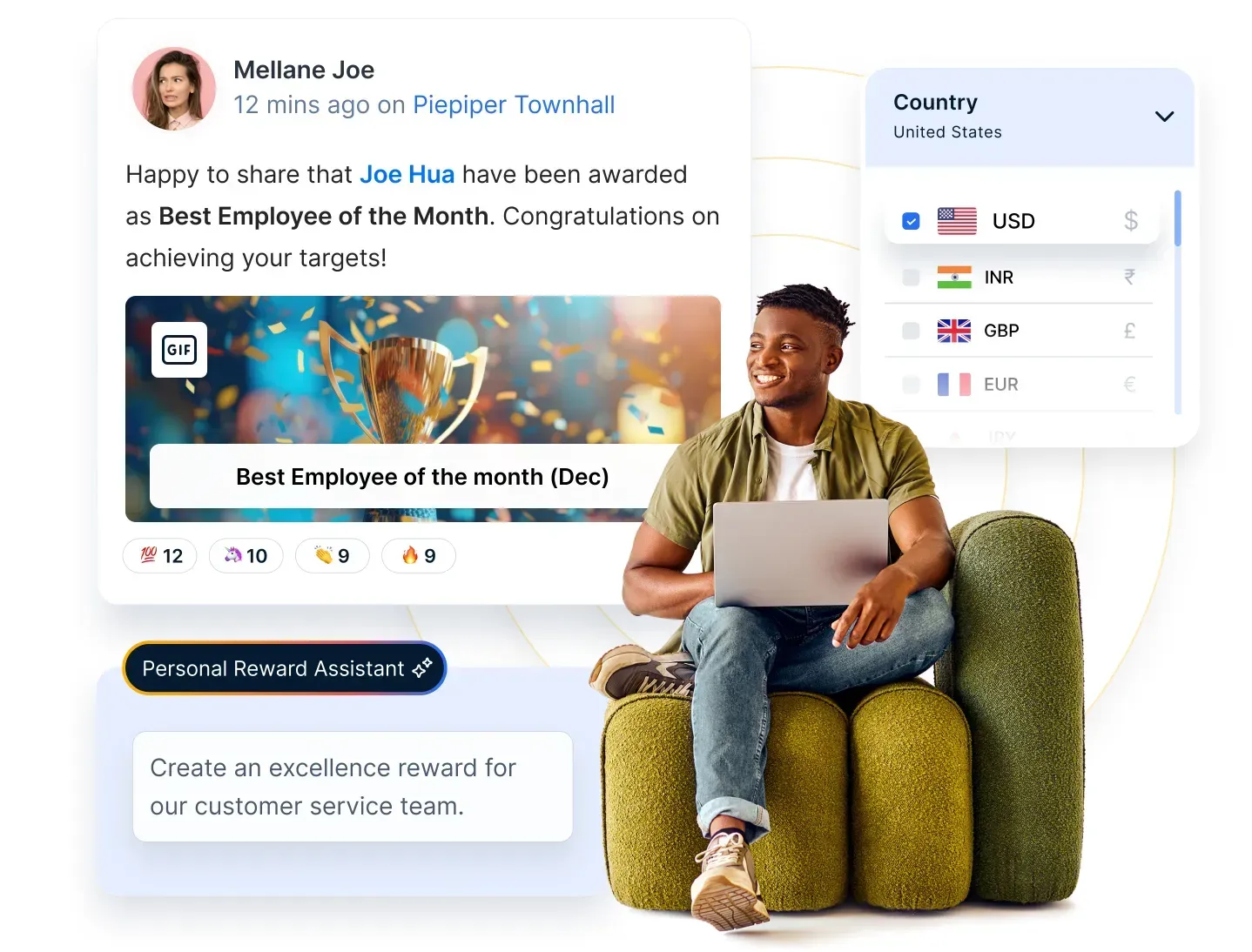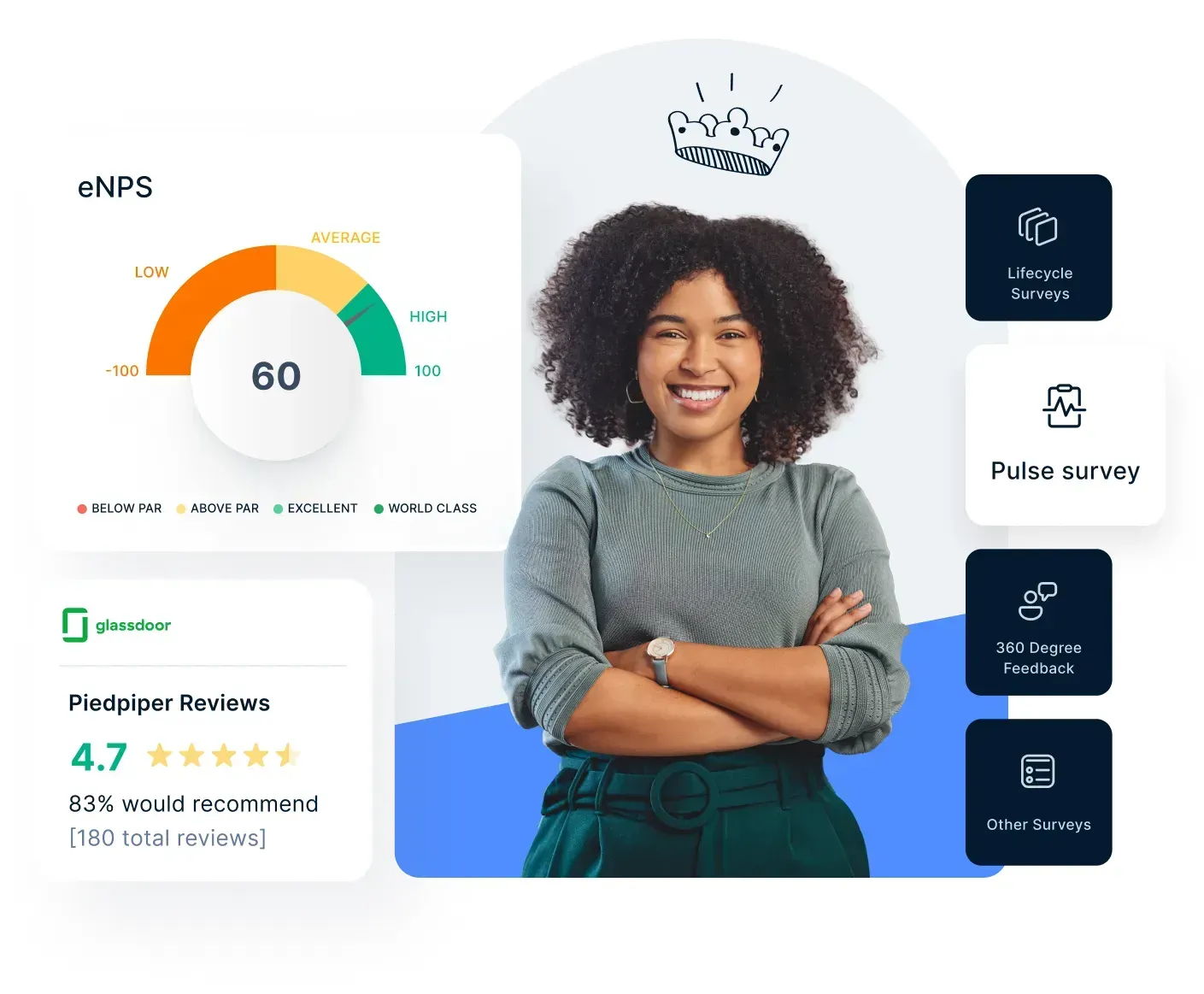Comment améliorer la rétention des employés : 13 façons créatives de les fidéliser
Découvrez comment améliorer la fidélisation des employés en relevant les principaux défis, en renforçant l'engagement et en créant un environnement de travail apprécié par les employés.
Sur cette page
- Qu'est-ce que la fidélisation des employés ?
- Défis liés à la fidélisation des employés
- Comment calculer le taux de rétention des employés ?
- Comment améliorer la rétention des employés : 13 stratégies les plus efficaces
- Liste de contrôle pour le suivi de la rétention des employés
- Renforcer la fidélisation des employés avec Empuls
- Conclusion
L'un des principaux problèmes des entreprises est d'améliorer la fidélisation de leurs employés. Selon les données du Bureau des statistiques du travailentre juillet et novembre 2022, plus de 4 millions d'Américains ont quitté volontairement leur emploi.
Pour corroborer cette étude, Gartner a révélé que le secteur des entreprises pourrait connaître un taux de rotation de 24 % dans les années à venir, ce qui incite les organisations à mettre en place de meilleures stratégies de fidélisation des employés.
Les employés sont considérés comme le plus grand atout d'une organisation, le deuxième étant les clients. Si vous traitez vos employés avec soin, ils refléteront ce sentiment à vos clients, ce qui vous permettra de vous démarquer du reste du marché. La clé de cette réussite est l'engagement des employés.
A étude Gallup a montré que les organisations dont les employés sont très engagés peuvent enregistrer une rentabilité supérieure de 21 %, ce qui plaide en faveur de la mise en œuvre de stratégies éprouvées de fidélisation des employés. Prenons l'exemple de grandes marques comme Facebook, Amazon, TATA et Google. Ces organisations, pour n'en citer que quelques-unes, ont une chose en commun : elles recrutent des talents et les gardent.
Dans le monde concurrentiel d'aujourd'hui, les travailleurs hautement qualifiés peuvent se sentir obligés de changer d'emploi s'ils reçoivent une meilleure offre. Un employé qui ne se sent pas engagé et respecté ou qui ne progresse pas dans votre entreprise commencera à chercher d'autres meilleures options.
Vous souhaitez donc réduire la rotation du personnel et améliorer la productivité. Dans ce cas, l'élaboration d'une stratégie efficace de fidélisation des employés devrait être une priorité sur votre liste de tâches.
Qu'est-ce que la fidélisation des employés ?
La fidélisation des employés englobe l'ensemble des efforts déployés par une organisation pour empêcher les membres de son personnel de partir. Dans une perspective beaucoup plus large, il s'agit de créer un environnement dans lequel les employés font l'expérience des trois R fondamentaux de la fidélisation des employés : le respect, la récompense et la reconnaissance.
Les programmes de fidélisation des employés peuvent varier en fonction des lacunes de l'entreprise. En voici quelques exemples :
- Mise en place de groupes de soutien entre pairs ou de conseils gratuits
- Intégration de technologies d'intelligence artificielle telles que Générateurs d'images AI, les créateurs de diaporamasou des logiciels de rédaction pour automatiser les tâches et faciliter le travail.
- Travail flexible et à distance
- le mentorat inversé, où les employés donnent un retour d'information à leurs supérieurs
Construisez ces programmes sur la base des valeurs fondamentales de la fidélisation des employés et profitez de l'avantage principal d'une meilleure expérience pour les employés, à savoir le recrutement des meilleurs talents qui resteront sur place.
Entre-temps, un rapport Gallagher prédit l'état de la fidélisation des employés en 2024. Selon ce rapport, 57 % des entreprises s'attendent à une augmentation de leurs effectifs. La fidélisation des salariés reste une priorité opérationnelle majeure, soulignant la nécessité pour les entreprises de redoubler d'efforts pour empêcher les salariés de partir.
Défis liés à la fidélisation des employés
Fidéliser les employés ne se limite pas à leur offrir un salaire. Les entreprises doivent relever les principaux défis qui ont un impact sur la satisfaction au travail, l'engagement et l'engagement à long terme. En identifiant ces obstacles et en mettant en œuvre des moyens créatifs pour retenir les employés, les entreprises peuvent créer un lieu de travail où les employés se sentent valorisés, motivés et désireux de rester.
1. Manque de possibilités d'évolution de carrière
Les employés quittent souvent l'entreprise lorsqu'ils se sentent coincés dans le même rôle, sans voie d'avancement claire. Les entreprises qui n'offrent pas de formation, de mentorat ou de promotion risquent de perdre leurs meilleurs talents au profit de leurs concurrents. Les programmes de développement professionnel et les ateliers d'acquisition de compétences sont des moyens créatifs de retenir les employés et de les motiver.
2. Rémunération et avantages sociaux inadéquats
Des salaires et des avantages compétitifs sont essentiels pour fidéliser les employés. Si les employés se sentent sous-payés ou si leurs avantages ne correspondent pas aux normes du secteur, ils sont plus susceptibles d'explorer d'autres possibilités d'emploi. Les primes basées sur les performances, les programmes de bien-être et les avantages personnalisés peuvent être des moyens créatifs de fidéliser les employés tout en améliorant la satisfaction au travail.
3. Mauvais équilibre entre vie professionnelle et vie privée
Les employés qui luttent pour maintenir un équilibre entre leur travail et leur vie personnelle sont souvent victimes d'épuisement professionnel. Des horaires rigides, une charge de travail excessive et des attentes irréalistes conduisent à l'insatisfaction et à une augmentation de la rotation du personnel. L'introduction de modalités de travail flexibles, d'options de travail à distance et de congés payés supplémentaires peut être un moyen créatif de retenir les employés et d'améliorer leur bien-être général.
4. Manque de reconnaissance et d'incitations
Les employés ont besoin de se sentir valorisés et appréciés pour leurs contributions. Lorsque les organisations ne reconnaissent pas les efforts ou ne récompensent pas les réalisations, la motivation et la loyauté diminuent. La mise en œuvre de programmes d'incitation, de plateformes de reconnaissance des employés et de récompenses non monétaires sont des moyens créatifs de retenir les employés et de favoriser une culture de l'appréciation.
5. Faiblesse de la culture d'entreprise et de l'engagement
Un environnement de travail toxique, un leadership médiocre et un manque de collaboration au sein de l'équipe peuvent faire fuir les employés. Les employés qui n'ont pas de sentiment d'appartenance sont moins susceptibles de rester fidèles à l'entreprise. Encourager une communication ouverte, promouvoir l'inclusion et organiser des activités de renforcement de l'esprit d'équipe sont des moyens créatifs de retenir les employés et de renforcer la culture du lieu de travail.
Comment calculer le taux de rétention des employés ?
Les RH doivent disposer de mesures spécifiques pour suivre les statistiques relatives au taux de rétention des employés lorsqu'elles discutent des stratégies de rétention des employés. En retraçant ces statistiques, vous saurez quelles initiatives exploitables pourraient être utilisées pour réduire les taux de maintien en poste du personnel.
Le calcul du taux de rétention des employés est simple : Diviser le nombre total de salariés ayant quitté l'entreprise au cours d'une période par le nombre total de salariés à la fin de la période pour obtenir le pourcentage.
Période : 3ème trimestre
Nombre total de salariés au début du 3e trimestre = 34
Nombre total de salariés ayant quitté l'entreprise au cours du 3e trimestre : 4
Calcul : 34-4 =30
Taux de rétention des employés = Nombre total de salariés ayant quitté l'entreprise au cours d'une période
Nombre total de salariés à la fin de la période
Taux de rétention des employés = 30 / 34 = 88%
Selon une étude du Center for American Progress, le coût du remplacement d'un employé ou d'un cadre hautement qualifié peut facilement dépasser le double de son salaire annuel. L'objectif de toute entreprise est de recruter du personnel talentueux et de le faire rester plus longtemps.
La fidélisation des employés n'est pas une tâche facile. Selon une étude récente de Willis Towers Watson, plus de la moitié des entreprises dans le monde déclarent avoir des difficultés à retenir certains de leurs employés les plus précieux.

Conservez vos meilleurs talents grâce à une reconnaissance significative
La fidélisation des employés commence par l'appréciation. Utilisez Empuls pour créer une culture de reconnaissance continue, de récompenses et d'engagement qui maintient les employés motivés et engagés.
Comment améliorer la rétention des employés : 13 stratégies les plus efficaces
Voici quelques conseils pour améliorer la fidélisation des employés. Certains de ces conseils vous sont peut-être déjà familiers, d'autres sont peut-être nouveaux pour vous, mais l'essentiel est que tous ces conseils vous aideront à stimuler la loyauté à long terme de vos employés les plus performants.
1. Analyser les raisons pour lesquelles les employés quittent
Si vous ne savez pas pourquoi les employés quittent votre entreprise, vous ne pourrez pas élaborer une stratégie efficace pour les inciter à rester.
Tout d'abord, examinez le taux de rotation moyen de votre secteur - votre taux de rotation du personnel est-il supérieur à la moyenne ?
La mise en œuvre d'un processus d'entretien de départ pour les employés qui quittent l'entreprise peut vous donner un aperçu des véritables raisons pour lesquelles les employés partent.
Après tout, ils sont plus enclins à être honnêtes lorsqu'ils partent, et si vous ne leur demandez pas vous-même, ils pourraient le dire au monde entier dans un avis négatif sur Glassdoor ou un autre site.
Examinez les tendances qui se dessinent une fois que vous avez commencé à rassembler vos données. Recevez-vous des commentaires de plusieurs employés sur des problèmes d'équilibre entre vie professionnelle et vie privée, des problèmes de gestion, des problèmes de culture d'entreprise, des retards dans le développement de carrière, ou autre chose ?
Qu'est-ce qui fait obstacle à votre stratégie de fidélisation des employés ? Vous ne pouvez pas résoudre un problème tant que vous ne l'avez pas identifié.
2. Examinez votre stratégie d'embauche
Tout commence par l'embauche. Les personnes qui vous quittent sont celles que vous avez embauchées. Examinez donc de plus près votre processus d'embaucheLes critères d'embauche comprennent les exigences du poste, la description du poste, les procédures d'entretien, la rémunération et les avantages sociaux, les rôles et les responsabilités.
Et voyez-vous un grand nombre d'employés démissionner quelques mois après leur embauche parce que le travail ne correspond pas à ce qu'ils pensaient ?
Vos descriptions de poste doivent être un regard honnête sur votre culture d'entreprise et une vue détaillée et précise des responsabilités du poste.
Les employés ne doivent pas être surpris par les aspects fondamentaux du travail après leur entrée en fonction - cela signifie que vous devez ajuster quelque chose dans le processus d'embauche, afin de recruter les bonnes personnes dès le départ et de définir les bonnes attentes.
3. Optimiser l'accueil des employés
Le premier jour sur un nouveau lieu de travail est souvent très similaire à ce que nous vivions le premier jour d'école : le trac, l'excitation de rencontrer de nouvelles personnes, d'apprendre de nouvelles choses, etc.
S'il est difficile pour les nouveaux employés de se familiariser avec le nouvel environnement, les personnes, les processus, les responsabilités professionnelles, etc., il est tout aussi difficile pour les managers.
Il incombe au manager de préparer le nouvel employé à réussir en le mettant à l'aise avec l'organisation et l'équipe dès le début (bien avant son premier jour de travail !).
Un plan intelligent, bien pensé et individuel pour chaque employé embauché peut être très utile. Assurez-vous que les employés ne sont pas seulement informés de leurs rôles et responsabilités, mais aussi de la culture de l'entreprise et de la manière dont ils peuvent s'épanouir chaque jour.
Mettez en place des plans et des objectifs pour la première semaine, le premier mois, le premier trimestre et ainsi de suite, afin qu'ils sachent clairement ce que l'on attend d'eux.
Des gestes comme la publication d'une annonce sur le portail intranet, la présentation des nouveaux employés, le jumelage avec un compagnon ou un mentor pour les aider à passer les premiers jours peuvent avoir un impact considérable.
En bref, l'expérience l'expérience d'accueil des employés doit être tout aussi planifiée et réfléchie que l'expérience d'accueil d'un client.
Les nouveaux employés participent au programme "Noogler"qui comprend une formation complète sur les valeurs de l'entreprise, les outils et les tâches spécifiques à l'emploi. Les études montrent que les organisations qui disposent d'un processus d'intégration solide améliorent le taux de rétention des nouveaux employés de 82% et la productivité de plus de 60%.
4. Investir dans le développement des employés
Un investissement dans la connaissance rapporte toujours les meilleurs intérêts." - Benjamin Franklin
L'un des moyens les plus simples de réduire la rotation du personnel est d'offrir de bonnes possibilités d'évolution de carrière. La principale raison pour laquelle les employés quittent une entreprise est qu'ils n'entrevoient pas de carrière satisfaisante à long terme.
Si vous n'offrez pas de possibilités de développement de carrière régulières et un système de promotion équitable, les employés seront frustrés et commenceront à chercher des emplois ailleurs.
Cela ne signifie pas que vous devez promouvoir chaque employé chaque année - ce n'est pas raisonnable, et vos employés le savent.
Mais ils veulent savoir à quoi pourrait ressembler leur parcours professionnel, avoir des discussions régulières sur l'évolution de leur carrière avec leurs responsables, et savoir que les possibilités de promotion sont clairement énoncées et équitablement réparties.
Perdre des personnes en raison d'opportunités d'apprentissage insuffisantes est probablement l'une des pires façons de perdre votre talent. Ce sont les personnes curieuses - curieuses d'apprendre de nouvelles technologies, techniques, processus, etc. - et les personnes curieuses font souvent d'excellents employés.
Ces employés sautent sur tous les nouveaux défis et réfléchissent à des solutions créatives.
En encourageant les employés à apprendre en permanence et à s'équiper des dernières tendances et technologies du marché, vous les empêcherez de partir.
Donner la priorité à l'investissement dans l'apprentissage et le développement professionnel des employés en allouant des fonds spéciaux pour les cours en ligne, en remboursant les frais de scolarité lorsque cela est nécessaire, en participant à des événements industriels, à des webinaires, à des conférences, etc.
5. Sélectionner les bons managers et les encadrer
Nous avons tous entendu la phrase familière "Les employés quittent les managers, pas les entreprises". Les managers ont un impact considérable sur les employés et les équipes.
Ils influencent directement le degré d'engagement et de motivation des employés et, par conséquent, la durée pendant laquelle ils sont susceptibles de continuer à travailler dans une organisation. Mais qu'est-ce que les employés n'aiment pas voir chez leurs managers ?
Il peut s'agir de faire du favoritisme, de faire des avances inappropriées ou de ne pas communiquer suffisamment, micromanagementne pas apprécier suffisamment, ne pas écouter suffisamment l'équipe, ne pas être décisif, ne pas offrir suffisamment d'opportunités d'apprentissage, etc., peuvent être extrêmement démotivants et pousser les employés à quitter l'organisation.
L'une des meilleures façons d'éviter cela et d'encourager une bonne relation entre le manager et le rapporteur est de faire en sorte qu'il n'y ait pas de conflit. bonne relation manager-reporter est d'équiper les managers avec le bon type de formation, de matériel d'apprentissage, etc.
Fournir aux managers suffisamment de fonds libres pour récompenser les membres de l'équipe et créer des liens avec l'équipe lors de déjeuners/dîners contribuera également à briser la glace. Utiliser des plates-formes technologiques pour un retour d'information individuel efficace et utiliser des plates-formes intranet sociales pour se connecter et collaborer avec l'équipe. l'intranet social pour se connecter et collaborer avec l'équipe. peuvent également contribuer à la constitution d'équipes performantes.
En sélectionnant soigneusement vos cadres et en leur donnant une formation approfondie sur les compétences de gestion, vous aidez vos superviseurs à réussir et vos employés à rester satisfaits.
6. Encourager la socialisation sur le lieu de travail
Lorsque je parle avec des personnes qui aiment leur travail et qui ont des amitiés vitales au travail, elles disent toujours que leur groupe de travail est comme une famille. - Tom Rath
Nous avons tendance à passer une plus grande partie de notre temps sur notre lieu de travail que dans notre famille. Ne pensez-vous pas qu'encourager les employés à nouer des amitiés solides sur le lieu de travail contribue à la création d'organisations fortes, connectées et heureuses ?
Les amitiés sur le lieu de travail rendent la venue au travail moins obligatoire, plus amusante et plus attendue.
La socialisation sur le lieu de travail va bien au-delà d'un verre avec un collègue le vendredi soir ou d'une journée bizarre de renforcement de l'équipe.
La création de liens "compatissants" et "significatifs" avec les collègues peut contribuer grandement à créer une main-d'œuvre heureuse et satisfaite.
Offrez à vos employés de multiples possibilités de briser la glace et de nouer des liens, que ce soit par le biais d'événements et de célébrations organisés régulièrement par l'entreprise ou de plateformes de communication performantes.
La socialisation sur le lieu de travail contribue grandement à la fidélisation des employés.
7. Établir la confiance par une communication transparente
Le plus grand problème de la communication est l'illusion qu'elle a eu lieu. - George Bernard Shaw
Une bonne communication, c'est comme un bon match de tennis : elle se compose de grandes volées.
La communication n'est plus ce qu'elle était il y a quelques dizaines d'années, lorsque la direction envoyait des notes de service ou affichait des annonces sur les tableaux d'affichage sans que les employés aient le moindre moyen de partager leurs points de vue et leurs opinions.
Dans le monde actuel, où tout va très vite, les employés s'attendent à être tenus au courant de l'évolution de leur entreprise et veulent exprimer leurs pensées et leurs opinions à ce sujet.
Les organisations les plus innovantes et les plus performantes n'attendent pas de voir des employés désengagés et à faible productivité. Elles investissent tout de même dans une plateforme technologique capable de connecter les employés, quel que soit l'endroit où ils travaillent, la région du monde ou l'appareil à partir duquel ils sont connectés.
Une plateforme numérique de communication et de collaboration comme un intranet vous permet d'explorer des moyens créatifs d'établir la communication, des messages rapides de la direction, de brèves conversations entre les responsables et les membres de l'équipe, des annonces des RH ou des sondages d'opinion.
Ces plateformes aident les dirigeants à rester en contact avec tous les employés et leur donnent de nombreuses occasions de partager leurs points de vue, idées, questions et préoccupations. Cela envoie un message fort, à savoir que la voix de l'employé est vitale pour le succès de l'organisation - ce qui augmente l'engagement et la rétention.
8. Montrer de la gratitude et de la reconnaissance
Reconnaissez et valorisez les personnes lorsqu'elles contribuent à la mission que vous partagez. Faites-le et vous allumerez leur objectif et leur potentiel. - Mike Byam
Une chose simple qui réduit considérablement la rotation du personnel est de reconnaître et de remercier les employés pour leur travail acharné.
Les stratégies visant à réduire la rotation du personnel ne doivent pas toujours être coûteuses et étendues - elles peuvent être aussi simples que de remarquer qu'une personne a fait un excellent travail et de lui dire pourquoi vous appréciez son dévouement et son travail.
Vous pouvez le faire en mettant en œuvre un programme de reconnaissance formel. Mais il est essentiel de ne pas ignorer les petits gestes. Les employés qui ne se sentent pas reconnus de manière adéquate sont deux fois plus susceptibles de démissionner au cours de l'année suivante - ce qui a un impact significatif sur le taux de rotation du personnel.
Et 65 % des employés déclarent n'avoir reçu aucune forme de reconnaissance pour leur bon travail au cours de l'année écoulée, ce qui laisse une grande marge d'amélioration dans presque toutes les organisations.
Personne ne déteste qu'on lui dise à quel point il a fait du bon travail. L'appréciation est quelque chose que tout le monde apprécie !
C'est pourquoi récompenses et reconnaissances ont un impact considérable sur la motivation et l'engagement des salariés, et donc sur la durée de leur collaboration avec l'entreprise. Elles donnent aux employés l'impression que l'organisation apprécie et respecte leur travail.
De plus, elle aide les employés à se concentrer et à trouver un but dans leurs activités quotidiennes. Tel est l'effet des récompenses et de la reconnaissance. Une étude réalisée par Bersin & Associates a montré que les entreprises dotées de programmes de reconnaissance très efficaces qui améliorent l'engagement des employés ont un taux de rotation volontaire inférieur de 31 %.
Prenez l'habitude de remercier vos coéquipiers lorsqu'ils font un effort supplémentaire, qu'il s'agisse d'un simple "merci" ou d'un "bravo" lors de la réunion hebdomadaire, d'une récompense lors du gala annuel ou d'un bon d'achat pour montrer votre appréciation.
La reconnaissance est d'autant plus puissante qu'elle est "sociale". Qu'il s'agisse d'une reconnaissance comme celle de l employé du mois ou d'une reconnaissance d'équipe, d'un anniversaire ou d'une fête de travail, les annonces sur les plateformes intranet sociales rassemblent l'organisation dans la célébration et remontent le moral des employés.
En outre, l'existence d'un programme structuré de récompenses et de reconnaissance aide l'organisation à s'aligner sur ses valeurs et ses convictions et à les renforcer. Le fait de savoir qui, au sein de l'organisation, est récompensé et reconnu, et pourquoi, représente une déclaration sans équivoque des valeurs et de la culture réelles de l'organisation.
Un grand nombre d'organisations prospères investissent également dans les idées et les innovations de leurs employés et les apprécient. Investir dans une plateforme formelle peut également permettre d'envoyer des vœux aux employés à l'occasion d'événements particuliers, d'anniversaires, d'anniversaires de travail, etc.
9. Demander l'avis des employés et y donner suite
"Le feedback est le petit-déjeuner des champions". - Ken Blanchard
Il devient difficile de conserver les employés si l'on n'a aucune idée ou si l'on se rend compte trop tard des défis auxquels ils sont confrontés, de ce qu'ils pensent de l'environnement de travail, s'ils ont besoin d'un soutien spécifique, etc.
Le retour d'information désuet, annuel ou semestriel, ne sert plus la cause - en particulier avec la génération actuelle, qui non seulement souhaite exprimer son opinion instantanément, mais attend également des actions rapides et une transformation du retour d'information partagé.
C'est là que l'organisation régulière (hebdomadaire/mensuelle) de séances de feedback individuel et d'enquêtes vient à la rescousse. Le retour d'information des employés peut s'avérer un outil puissant pour stimuler l'engagement et le moral.
Les employés se sentent responsabilisés lorsqu'ils sont encouragés à partager leurs idées, leurs pensées et leurs points de vue sur les différents événements au sein de l'équipe ou de l'organisation.
Réaliser des enquêtes de temps en temps pour prendre le pouls de l'organisation ou pour recueillir des avis sur des domaines d'activité spécifiques peut s'avérer très bénéfique.
Les enquêtes sur le cycle de vie peuvent également aider à mesurer les "moments qui comptent" à travers les étapes telles que l'intégration, le changement de rôle, la célébration d'un anniversaire au travail, etc. La capture et l'analyse des expériences des employés peuvent aider à comprendre les défis plus tôt et donc à prendre des mesures plus rapidement.
Si la collecte de commentaires résout une partie du problème, elle ne fait pas une grande différence tant que vous ne prenez pas de mesures en fonction des commentaires reçus.
Agir en temps utile et communiquer aux employés les mesures prises pour répondre aux préoccupations et aux commentaires partagés fait la différence.
10. Valoriser la santé et le bien-être des employés
"La forme physique n'est pas seulement l'une des clés les plus importantes d'un corps sain, elle est la base d'une activité intellectuelle dynamique et créative." - John F. Kennedy
Les organisations du monde entier mettent de plus en plus l'accent sur la santé et le bien-être de leurs employés, et très peu de travailleurs sont prêts à tolérer de longues heures de travail et des conditions de travail malsaines.
En outre, recherche montrent que les employés stressés, débordés et surmenés sont susceptibles de tomber malades plus fréquemment. Au fil du temps, la surcharge de travail des employés peut entraîner une perte de productivité, une baisse du moral et un taux de rotation plus élevé.
Reconnaître le rôle vital que jouent la santé et le bien-être des employés - physique, émotionnel, mental ou financier - dans l'engagement des employés et le développement d'une culture d'entreprise forte peut contribuer grandement à réduire le taux de rotation du personnel.
Qu'il s'agisse d'encourager les employés à prendre des congés payés et des pauses de temps en temps pour se détendre et se relaxer, d'augmenter les effectifs lorsque cela est nécessaire, de leur donner des conseils d'experts pour prendre des décisions financières judicieuses, d'organiser régulièrement des séances de conseil pour garantir une bonne santé mentale, d'organiser des cours de yoga et de méditation ou de sponsoriser leurs frais de gym, les employés apprécient les organisations qui encouragent leur bien-être.
Les employés quittent souvent les entreprises parce qu'ils se sentent épuisés - leurs horaires sont trop longs, leurs vacances sont trop courtes et rares, et ils n'ont pas le temps d'être des êtres humains complets et des travailleurs productifs.
Si les employés qui partent vous disent, lors des entretiens de départ, que c'est la raison de leur départ, examinez de près vos politiques.
11. Mener des entretiens de sortie
Selon Robert Half83% des organisations ne font pas d'entretiens de départ. Même si l'organisation est amicale et ouverte, les employés sont voués à partir et à changer d'organisation.
Vous devez veiller à mener des entretiens de départ avant le départ des employés. Les entretiens de départ sont la dernière occasion de comprendre ce qui n'a pas fonctionné et pourquoi vous perdez l'employé.
L'entretien de sortie peut comporter quelques questions telles que :
- Qu'est-ce que vous aimez le plus et le moins dans votre travail ?
- Y a-t-il eu des éléments qui vous ont empêché d'exercer vos fonctions conformément aux attentes ?
- Quelles suggestions pourriez-vous faire pour améliorer les problèmes que vous avez rencontrés sur votre lieu de travail ?
- Y a-t-il quelque chose que l'organisation aurait pu faire mais qu'elle n'a pas fait jusqu'à présent ?
12. Suivre l'évolution des rémunérations
Cela semble essentiel, mais trop d'employeurs négligent l'importance de maintenir une rémunération et des avantages sociaux adéquats pour leurs employés.
Supposons que vous ne vous assuriez pas régulièrement que votre rémunération totale et vos avantages sociaux sont compétitifs par rapport aux autres entreprises de votre secteur. Dans ce cas, vous incitez vos employés à chercher du travail ailleurs.
Après tout, les employés travaillent parce qu'ils ont besoin de subvenir à leurs besoins, et c'est ce qu'un salaire équitable et des avantages compétitifs leur permettent de faire. Le remplacement d'un employé est coûteux. Une augmentation des salaires ou l'ajout de quelques avantages sociaux pourrait contribuer à votre résultat net en réduisant le taux de rotation du personnel.
13. Lâcher prise lorsque c'est nécessaire
Un seul mauvais élève peut entraîner toute une équipe et faire fuir vos meilleurs employés.
Un employé toxique - qui n'est pas à la hauteur, qui met les autres mal à l'aise ou qui cause régulièrement des problèmes - peut avoir un effet significatif sur l'ensemble de votre environnement de travail.
Tous les employés que vous embauchez ne sont pas forcément adaptés à long terme, et ce n'est pas grave. Vous devez vérifier les raisons pour lesquelles vous n'avez pas embauché le bon employé afin d'éviter de répéter l'erreur.
Mais il serait utile que vous preniez des mesures d'adaptation le plus tôt possible afin de ne pas perdre les employés qui s'adaptent et contribuent.
Liste de contrôle pour le suivi de la rétention des employés
Vous trouverez ci-dessous la liste de contrôle que vous pouvez utiliser lors de la planification d'une stratégie de maintien en poste du personnel pour votre organisation.
- Mesurez le taux de rétention de vos employés.
- Utilisez des stratégies de fidélisation établies et vérifiées, et évitez les suppositions. Appuyez-vous sur des données et des informations avant d'agir.
- Évitez de supposer à tort que vos employés sont heureux ; demandez régulièrement à vos employés de vous faire part de leurs commentaires. Comprenez le pourquoi avant de conclure le quoi et le comment.
- Mener des entretiens de départ pour comprendre ce qui n'a pas fonctionné et identifier les domaines nécessitant une amélioration.
Renforcer la fidélisation des employés avec Empuls

Retenir les meilleurs talents n'est pas seulement une question de salaires ou de promotions. Il s'agit de créer un environnement dans lequel les employés se sentent valorisés, connectés et motivés pour rester. Une stratégie solide de fidélisation des employés se concentre sur l'engagement continu, la reconnaissance significative et la création d'une culture d'entreprise que les employés ne veulent pas quitter.
C'est ici que Empuls joue un rôle crucial. En combinant la reconnaissance, les récompenses, le feedback et l'engagement en une seule plateforme, Empuls aide les entreprises à développer un sentiment d'appartenance et d'engagement chez leurs employés.
Comment Empuls contribue à améliorer la fidélisation des employés
✅ Une reconnaissance qui compte: Célébrez les contributions des employés par une reconnaissance entre pairs et une appréciation en temps réel, en renforçant une culture de la gratitude.
✅ Des récompenses et des incitations personnalisées: Offrez des récompenses flexibles qui s'alignent sur les préférences des employés, rendant la reconnaissance plus impactante et significative.
✅ Un retour d'information sur les employés exploitable: Tirez parti des enquêtes et de l'analyse des sentiments pour recueillir des informations, répondre aux préoccupations et améliorer la satisfaction des employés.
✅ Des liens plus forts sur le lieu de travail: Développez un sentiment d'appartenance grâce à des fonctionnalités d'engagement numérique qui encouragent la collaboration et la cohésion d'équipe.
✅ Un engagement et une motivation continus: Maintenez l'inspiration des employés grâce à une reconnaissance régulière, à des célébrations d'étapes et à des incitations basées sur les performances.
La fidélisation ne consiste pas seulement à réduire le taux de rotation du personnel. Il s'agit de maintenir les employés engagés, heureux et engagés dans le succès de votre organisation. Empuls aide les entreprises à créer une culture dans laquelle les employés se sentent valorisés et motivés pour rester à long terme.
Conclusion
Suivez la règle du pouce d'or. Mettez-vous à la place de votre employé et essayez de voir où les choses ne vont pas. Lorsque vous essayez d'améliorer votre lieu de travail en apportant les changements nécessaires, vos employés le remarqueront. C'est ce qui permettra à votre entreprise de connaître un grand succès.
La fidélisation des employés est un défi permanent auquel toutes les organisations sont confrontées, quelle que soit leur taille. Utilisez la liste ci-dessus des moyens de réduire la rétention des employés comme point de départ pour élaborer vos stratégies de rétention des employés. Une fois que vous les aurez préparées, mettez-les à l'essai et constatez la différence dans les taux de fidélisation des employés.
Tout ce que vous avez à faire est d'identifier les points que vous devez inclure, de formuler ces points sous forme de stratégies, de les essayer si c'est un succès bingo vous y êtes arrivé, et si ce n'est pas le cas, d'identifier et d'apporter les changements nécessaires au fur et à mesure.












